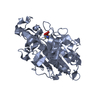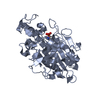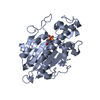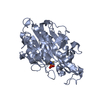+ Open data
Open data
- Basic information
Basic information
| Entry | Database: PDB / ID: 7yjp | ||||||
|---|---|---|---|---|---|---|---|
| Title | Crystal structure of MCR-1 treated by AuCl | ||||||
 Components Components | Probable phosphatidylethanolamine transferase Mcr-1 | ||||||
 Keywords Keywords |  TRANSFERASE / MCR-1-S / AuCl / TRANSFERASE / MCR-1-S / AuCl /  ANTIBIOTIC ANTIBIOTIC | ||||||
| Function / homology |  Function and homology information Function and homology informationtransferase activity, transferring phosphorus-containing groups /  Transferases; Transferring phosphorus-containing groups / response to antibiotic / Transferases; Transferring phosphorus-containing groups / response to antibiotic /  plasma membrane plasma membraneSimilarity search - Function | ||||||
| Biological species |   Escherichia coli (E. coli) Escherichia coli (E. coli) | ||||||
| Method |  X-RAY DIFFRACTION / X-RAY DIFFRACTION /  SYNCHROTRON / SYNCHROTRON /  SAD / Resolution: 1.88 Å SAD / Resolution: 1.88 Å | ||||||
 Authors Authors | Zhang, Q. / Wang, M. / Sun, H. | ||||||
| Funding support |  Hong Kong, 1items Hong Kong, 1items
| ||||||
 Citation Citation |  Journal: J.Biol.Inorg.Chem. / Year: 2023 Journal: J.Biol.Inorg.Chem. / Year: 2023Title: Gold drugs as colistin adjuvants in the fight against MCR-1 producing bacteria. Authors: Zhang, Q. / Wang, M. / Hu, X. / Yan, A. / Ho, P.L. / Li, H. / Sun, H. | ||||||
| History |
|
- Structure visualization
Structure visualization
| Structure viewer | Molecule:  Molmil Molmil Jmol/JSmol Jmol/JSmol |
|---|
- Downloads & links
Downloads & links
- Download
Download
| PDBx/mmCIF format |  7yjp.cif.gz 7yjp.cif.gz | 136.8 KB | Display |  PDBx/mmCIF format PDBx/mmCIF format |
|---|---|---|---|---|
| PDB format |  pdb7yjp.ent.gz pdb7yjp.ent.gz | 107.9 KB | Display |  PDB format PDB format |
| PDBx/mmJSON format |  7yjp.json.gz 7yjp.json.gz | Tree view |  PDBx/mmJSON format PDBx/mmJSON format | |
| Others |  Other downloads Other downloads |
-Validation report
| Arichive directory |  https://data.pdbj.org/pub/pdb/validation_reports/yj/7yjp https://data.pdbj.org/pub/pdb/validation_reports/yj/7yjp ftp://data.pdbj.org/pub/pdb/validation_reports/yj/7yjp ftp://data.pdbj.org/pub/pdb/validation_reports/yj/7yjp | HTTPS FTP |
|---|
-Related structure data
| Related structure data |  7yjqC  7yjrC  7yjsC  7yjtC C: citing same article ( |
|---|---|
| Similar structure data | Similarity search - Function & homology  F&H Search F&H Search |
- Links
Links
- Assembly
Assembly
| Deposited unit | 
| ||||||||
|---|---|---|---|---|---|---|---|---|---|
| 1 | 
| ||||||||
| 2 | 
| ||||||||
| Unit cell |
|
- Components
Components
| #1: Protein | Mass: 37231.473 Da / Num. of mol.: 2 Source method: isolated from a genetically manipulated source Source: (gene. exp.)   Escherichia coli (E. coli) / Gene: mcr1, mcr-1, APZ14_31440 / Production host: Escherichia coli (E. coli) / Gene: mcr1, mcr-1, APZ14_31440 / Production host:   Escherichia coli (E. coli) Escherichia coli (E. coli)References: UniProt: A0A0R6L508,  Transferases; Transferring phosphorus-containing groups Transferases; Transferring phosphorus-containing groups#2: Chemical | #3: Water | ChemComp-HOH / |  Water WaterHas ligand of interest | Y | |
|---|
-Experimental details
-Experiment
| Experiment | Method:  X-RAY DIFFRACTION / Number of used crystals: 1 X-RAY DIFFRACTION / Number of used crystals: 1 |
|---|
- Sample preparation
Sample preparation
| Crystal | Density Matthews: 2.14 Å3/Da / Density % sol: 42.42 % |
|---|---|
Crystal grow | Temperature: 293 K / Method: vapor diffusion, sitting drop / pH: 8 Details: 100mM Tris-HNO3, pH 8.0, 32% PEG 3350, 25% Glycerol, 5mM AuCl |
-Data collection
| Diffraction | Mean temperature: 100 K / Serial crystal experiment: N | ||||||||||||||||||||||||
|---|---|---|---|---|---|---|---|---|---|---|---|---|---|---|---|---|---|---|---|---|---|---|---|---|---|
| Diffraction source | Source:  SYNCHROTRON / Site: SYNCHROTRON / Site:  SSRF SSRF  / Beamline: BL17U / Wavelength: 0.97915 Å / Beamline: BL17U / Wavelength: 0.97915 Å | ||||||||||||||||||||||||
| Detector | Type: ADSC QUANTUM 315r / Detector: CCD / Date: Jan 19, 2019 | ||||||||||||||||||||||||
| Radiation | Protocol: SINGLE WAVELENGTH / Monochromatic (M) / Laue (L): M / Scattering type: x-ray | ||||||||||||||||||||||||
| Radiation wavelength | Wavelength : 0.97915 Å / Relative weight: 1 : 0.97915 Å / Relative weight: 1 | ||||||||||||||||||||||||
| Reflection | Resolution: 1.88→58.093 Å / Num. obs: 48894 / % possible obs: 96.1 % / Redundancy: 3.4 % / CC1/2: 0.997 / Rmerge(I) obs: 0.059 / Rpim(I) all: 0.038 / Rrim(I) all: 0.07 / Net I/σ(I): 11.7 | ||||||||||||||||||||||||
| Reflection shell | Diffraction-ID: 1
|
- Processing
Processing
| Software |
| ||||||||||||||||||||||||||||||||||||||||||||||||||||||||||||||||||||||||||||||||||||||||||||||||||||||||||||
|---|---|---|---|---|---|---|---|---|---|---|---|---|---|---|---|---|---|---|---|---|---|---|---|---|---|---|---|---|---|---|---|---|---|---|---|---|---|---|---|---|---|---|---|---|---|---|---|---|---|---|---|---|---|---|---|---|---|---|---|---|---|---|---|---|---|---|---|---|---|---|---|---|---|---|---|---|---|---|---|---|---|---|---|---|---|---|---|---|---|---|---|---|---|---|---|---|---|---|---|---|---|---|---|---|---|---|---|---|---|
| Refinement | Method to determine structure : :  SAD / Resolution: 1.88→58.093 Å / SU ML: 0.23 / Cross valid method: THROUGHOUT / σ(F): 1.34 / Phase error: 31.68 / Stereochemistry target values: ML SAD / Resolution: 1.88→58.093 Å / SU ML: 0.23 / Cross valid method: THROUGHOUT / σ(F): 1.34 / Phase error: 31.68 / Stereochemistry target values: ML
| ||||||||||||||||||||||||||||||||||||||||||||||||||||||||||||||||||||||||||||||||||||||||||||||||||||||||||||
| Solvent computation | Shrinkage radii: 0.9 Å / VDW probe radii: 1.11 Å / Solvent model: FLAT BULK SOLVENT MODEL | ||||||||||||||||||||||||||||||||||||||||||||||||||||||||||||||||||||||||||||||||||||||||||||||||||||||||||||
| Displacement parameters | Biso max: 98.2 Å2 / Biso mean: 41.2595 Å2 / Biso min: 21.98 Å2 | ||||||||||||||||||||||||||||||||||||||||||||||||||||||||||||||||||||||||||||||||||||||||||||||||||||||||||||
| Refinement step | Cycle: final / Resolution: 1.88→58.093 Å
| ||||||||||||||||||||||||||||||||||||||||||||||||||||||||||||||||||||||||||||||||||||||||||||||||||||||||||||
| LS refinement shell | Refine-ID: X-RAY DIFFRACTION / Rfactor Rfree error: 0
|
 Movie
Movie Controller
Controller



 PDBj
PDBj





